Review: Invasion science: A Horizon Scan of emerging challenges and opportunities ($)
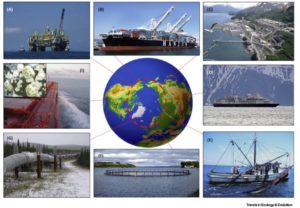 Ricciardi et al. describe the conclusions from a “horizon scanning” workshop set up “to identify emerging scientific, technological, and sociopolitical issues that are likely to affect how invasion processes and dynamics are studied and managed within the next 20 years.” Key concerns include expanding transportation networks, global environmental change, genomic modification tools (which offer both risks and potential solutions to managing invasions), the commercial use of microbes to facilitate crop production, and increased human activities in the Arctic. For each, the potential for harm and mitigation strategies are discussed. Trends Ecol. Evol. 10.1016/j.tree.2017.03.007
Ricciardi et al. describe the conclusions from a “horizon scanning” workshop set up “to identify emerging scientific, technological, and sociopolitical issues that are likely to affect how invasion processes and dynamics are studied and managed within the next 20 years.” Key concerns include expanding transportation networks, global environmental change, genomic modification tools (which offer both risks and potential solutions to managing invasions), the commercial use of microbes to facilitate crop production, and increased human activities in the Arctic. For each, the potential for harm and mitigation strategies are discussed. Trends Ecol. Evol. 10.1016/j.tree.2017.03.007


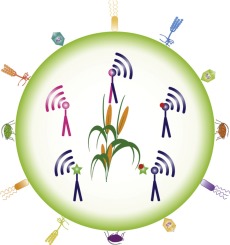 Cell-surface localized immune receptors are one of the ways that plants detect pathogens. Traditionally, these receptors have been introgressed from resistant to susceptible varieties through classical breeding. More recently, it has become possible to use genetic engineering methods to move immune receptor genes between more distantly-related plants, where they are able to confer resistance. Rodriguez-Moreno et al. review these trans-family gene transfers and also efforts to expand the recognition spectrum more broadly through directed evolution and gene editing. They also describe efforts to identify novel variants of intracellular nucleotide-binding domain leucine-rich repeat receptors (NLRs). However, they observe that “strategies based on the transfer of individual immune receptor genes can be rapidly overcome under field conditions, and pyramiding of immune receptors that recognize different ligands is imperative.” Curr. Opin. Plant Biol.
Cell-surface localized immune receptors are one of the ways that plants detect pathogens. Traditionally, these receptors have been introgressed from resistant to susceptible varieties through classical breeding. More recently, it has become possible to use genetic engineering methods to move immune receptor genes between more distantly-related plants, where they are able to confer resistance. Rodriguez-Moreno et al. review these trans-family gene transfers and also efforts to expand the recognition spectrum more broadly through directed evolution and gene editing. They also describe efforts to identify novel variants of intracellular nucleotide-binding domain leucine-rich repeat receptors (NLRs). However, they observe that “strategies based on the transfer of individual immune receptor genes can be rapidly overcome under field conditions, and pyramiding of immune receptors that recognize different ligands is imperative.” Curr. Opin. Plant Biol.  Many agricultural lands are becoming saltier as a consequence of irrigation and sea water incursion, yet most crops are very sensitive to salt. Salt glands that accumulate and secrete salt have evolved independently at least 12 times in plants. Dassanayake and Larkin review the structure, function and evolution of salt glands, and describe how model species with salt glands (including ice plant and quinoa) are useful for electrophysiology and genetic studies. The authors conclude with a fascinating thought-experiment about whether we could engineer salt glands into other species. The short answer: yes, in theory, but it “would be a substantial test of our skills in combining –omics data, cell biology, and classical whole plant physiology to understand and manipulate a plant’s response to environmental stress.” Front. Plant Science
Many agricultural lands are becoming saltier as a consequence of irrigation and sea water incursion, yet most crops are very sensitive to salt. Salt glands that accumulate and secrete salt have evolved independently at least 12 times in plants. Dassanayake and Larkin review the structure, function and evolution of salt glands, and describe how model species with salt glands (including ice plant and quinoa) are useful for electrophysiology and genetic studies. The authors conclude with a fascinating thought-experiment about whether we could engineer salt glands into other species. The short answer: yes, in theory, but it “would be a substantial test of our skills in combining –omics data, cell biology, and classical whole plant physiology to understand and manipulate a plant’s response to environmental stress.” Front. Plant Science 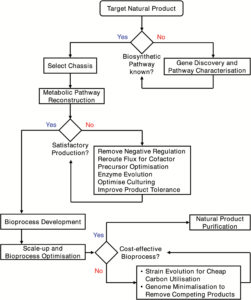 The excellent review by Moses et al. starts by defining the oft-confused terms metabolite engineering and systems biology. Although systems biology can contribute to the former, it is distinguished by the use of “defined ‘parts’ that are easily combined and exchanged, using standardized workflows and often combined with modelling and computational methods.” The authors go on to describe the use of systems biology tools for the production of high-value metabolites in single celled hosts (yeast, algae, and bacteria). This review spans a wide breadth of topics, from strengths and weakness of different unicellular hosts, to approaches for regulating gene expression level, and protein engineering and scaffolding. As well as providing a nice overview of this rapidly-advancing field for scientists, this review is also a great resource for use in teaching. J. Exp. Bot.
The excellent review by Moses et al. starts by defining the oft-confused terms metabolite engineering and systems biology. Although systems biology can contribute to the former, it is distinguished by the use of “defined ‘parts’ that are easily combined and exchanged, using standardized workflows and often combined with modelling and computational methods.” The authors go on to describe the use of systems biology tools for the production of high-value metabolites in single celled hosts (yeast, algae, and bacteria). This review spans a wide breadth of topics, from strengths and weakness of different unicellular hosts, to approaches for regulating gene expression level, and protein engineering and scaffolding. As well as providing a nice overview of this rapidly-advancing field for scientists, this review is also a great resource for use in teaching. J. Exp. Bot. 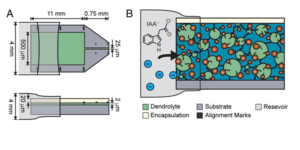 Many insights about hormone function have come from “spray and pray” studies, but generally the precision of application of the hormone limits their value. Poxson et al. describe an adaption of an organic electronic ionic pump (OEIP; developed originally for studies of mammalian cells) for introducing small quantities of the hormone auxin to a precise location. For use in these studies, the OEIP was adapted to incorporate hyperbranched polymers (dendrolytes) as a matrix. Auxin movement and release from the pump is controlled electronically. The authors demonstrated the effectiveness of IAA delivery through root growth rate and positive and negative reporters (35S::DII-Venus or DR5rev::GFP). This study demonstrates the potential for the application of OEIP technology toward plant research. Proc. Natl. Acad. Sci. USA
Many insights about hormone function have come from “spray and pray” studies, but generally the precision of application of the hormone limits their value. Poxson et al. describe an adaption of an organic electronic ionic pump (OEIP; developed originally for studies of mammalian cells) for introducing small quantities of the hormone auxin to a precise location. For use in these studies, the OEIP was adapted to incorporate hyperbranched polymers (dendrolytes) as a matrix. Auxin movement and release from the pump is controlled electronically. The authors demonstrated the effectiveness of IAA delivery through root growth rate and positive and negative reporters (35S::DII-Venus or DR5rev::GFP). This study demonstrates the potential for the application of OEIP technology toward plant research. Proc. Natl. Acad. Sci. USA 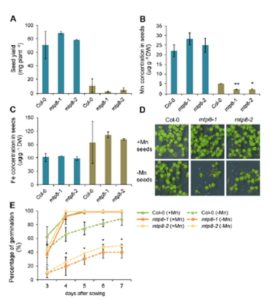 Plants and seeds are the main dietary source of essential micronutrients in the food chain. The processes regulating transport of micronutrients to and within seeds are critical for germination and enrichment of seeds. Metal transport protein 8 (MTP8) has been characterized as a tonoplast Mn transporter in Arabidopsis roots preventing plants from Mn toxicity. In this paper the authors further characterize the role of MTP8 in Arabidopsis. Using yeast as a heterologous expression system, Eroglu et al. demonstrated that MTP8 restores the growth of yeast mutant defective in vacuolar Fe transport. They further report that the MTP8 is also responsible for a characteristic enrichment of Mn in cortical cells of the hypocotyl and in subepidermal cells of cotyledons, as well as for Mn homeostasis during imbibition and germination under changing water conditions. (Summary by
Plants and seeds are the main dietary source of essential micronutrients in the food chain. The processes regulating transport of micronutrients to and within seeds are critical for germination and enrichment of seeds. Metal transport protein 8 (MTP8) has been characterized as a tonoplast Mn transporter in Arabidopsis roots preventing plants from Mn toxicity. In this paper the authors further characterize the role of MTP8 in Arabidopsis. Using yeast as a heterologous expression system, Eroglu et al. demonstrated that MTP8 restores the growth of yeast mutant defective in vacuolar Fe transport. They further report that the MTP8 is also responsible for a characteristic enrichment of Mn in cortical cells of the hypocotyl and in subepidermal cells of cotyledons, as well as for Mn homeostasis during imbibition and germination under changing water conditions. (Summary by 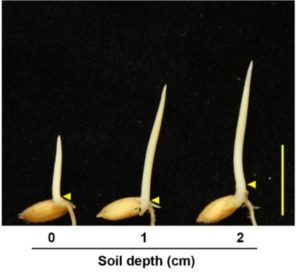 During germination, the rice shoot is protected by the coleoptile, which is a highly light and hormone-sensitive tissue. While searching for genes involved in ethylene responses, Xiong et al. identified a mutant with an elongated coleoptile, in which the subtending mesocotyl is also elongated; they named this mutant gaoyao1 (gy1), a Chinese name meaning “high waist”. Map-based cloning revealed that GY1 encodes a plastid-localized phospholipase involved in the synthesis of jasmonic acid (JA). They found that ethylene (which promotes coleoptile elongation) represses expression of GY1, and that JA represses coleoptile growth. Furthermore, they found natural allelic variation of the GY1 gene associated with longer coleoptiles. These findings provide new insights into the regulation of seedling establishment and can be used to select for coleoptile length in breeding programs. Plant Cell
During germination, the rice shoot is protected by the coleoptile, which is a highly light and hormone-sensitive tissue. While searching for genes involved in ethylene responses, Xiong et al. identified a mutant with an elongated coleoptile, in which the subtending mesocotyl is also elongated; they named this mutant gaoyao1 (gy1), a Chinese name meaning “high waist”. Map-based cloning revealed that GY1 encodes a plastid-localized phospholipase involved in the synthesis of jasmonic acid (JA). They found that ethylene (which promotes coleoptile elongation) represses expression of GY1, and that JA represses coleoptile growth. Furthermore, they found natural allelic variation of the GY1 gene associated with longer coleoptiles. These findings provide new insights into the regulation of seedling establishment and can be used to select for coleoptile length in breeding programs. Plant Cell  The best science happens when all hypotheses are considered and all voices are heard. Not only that: If important safety information isn’t communicated among all lab members, someone could get hurt.
The best science happens when all hypotheses are considered and all voices are heard. Not only that: If important safety information isn’t communicated among all lab members, someone could get hurt. This week we spoke to Professor
This week we spoke to Professor